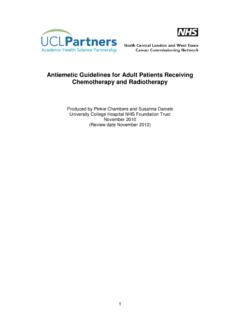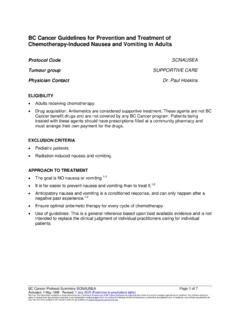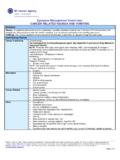Transcription of Emerging Treatments in Chemotherapy-Induced …
1 Abstract: Chemotherapy-Induced nausea and vomiting (CINV) is a concern for many cancer patients. It can have an enormous impact on quality of life. CINV occurring in the first 24 hours after treatment is considered acute, and CINV occurring on days 2 through 5 after treatment is considered delayed. Anticipatory nausea and depression can also occur when patients are reminded of their chemotherapy treatment. CINV can lead to weight changes, fatigue, and the need for additional medications. Even mild to moderate CINV can increase health care utilization and costs, as well as delay treatment. nausea and vomiting are separate events, although their mechanisms are entwined. Drugs that stop vomiting do not necessarily treat nausea . Control of CINV allows patients to complete treatment and to minimize use of health care resources and additional medications. Current antiemesis agents, such as 5-hydroxytryptamine-3 (5-HT3) antagonists and neurokinin-1 (NK-1) antagonists, have markedly decreased hospitalization for chemotherapy and have nearly eliminated acute emesis.
2 The second-generation 5-HT3 receptor palonosetron has a unique pharmacology that makes it especially effective at preventing delayed Roundtable MonographModeratorSteven M. Grunberg, MDProfessor of MedicineThe University of VermontCollege of MedicineBurlington, VermontDiscussantsBarbara Slusher, PhDDirector, Brain Science Institute NeuroTranslational Drug Discovery ProgramAssociate Professor of Neurology and PsychiatryJohns Hopkins UniversityBaltimore, MarylandHope S. Rugo, MDProfessor of MedicineDirector, Breast Oncology and Clinical Trials EducationUCSF Helen Diller Family Comprehensive Cancer CenterSan Francisco, CaliforniaClinical Advances in Hematology & Oncology February 2013 Emerging Treatments in Chemotherapy-Induced nausea and VomitingSupported through an educational grant from Eisai CME Activity Approved for AMA PRA Category 1 Credit(s) TMRelease Date: February 2013 Expiration Date: February 28, 2014 Estimated time to complete activity: hoursProject ID: 9133 DisclaimerFunding for this clinical roundtable monograph has been provided through an educational grant from Eisai Inc.
3 Support of this monograph does not imply the supporter s agreement with the views expressed herein. Every effort has been made to ensure that drug usage and other information are presented accurately; however, the ultimate responsibility rests with the prescribing physician. Millennium Medical Publishing, Inc., the sup-porter, and the participants shall not be held responsible for errors or for any consequences arising from the use of information contained herein. Readers are strongly urged to consult any relevant primary literature. No claims or endorsements are made for any drug or compound at present under clinical investigation. 2013 Millennium Medical Publishing, Inc., 611 Broadway, Suite 310, New York, NY 10012. Printed in the USA. All rights reserved, including the right of reproduction, in whole or in part, in any AudienceThis activity has been designed for oncologists, hematologists, and oncology nurses who treat cancer patients who receive of Need/Program OverviewChemotherapy- induced nausea and vomiting (CINV) is a common side effect of chemotherapy .
4 The most important factor in determining whether CINV will occur is the chemotherapy itself. Risk is higher in women and younger patients. CINV can have an enormous impact on quality of life and can lead to fatigue, weight gain, and an inability to conduct activities of daily living. Patients with CINV may require additional medications or even a change in their chemotherapy regimen. CINV prevention is the primary principle of emesis control, as outlined by the major antiemetic guidelines. nausea and vomiting are related but separate events, as sug-gested by agents that treat one more effectively than the other. Physicians must be familiar with the different treatment strategies best for acute nau-sea, delayed nausea , acute vomiting , and delayed vomiting . Educational ObjectivesAfter completing this activity, the participant should be better able to: Identify patients at greater risk of Chemotherapy-Induced nausea and vom-iting (CINV) Recognize the impact of CINV on general patient functioning Utilize treatment strategies for acute versus delayed CINV and for nausea versus vomiting Distinguish among the various 5-hydroxytryptamine-3 (5-HT3) antago-nistsAccreditation StatementThis activity has been planned and implemented in accordance with the Essential Areas and policies of the Accreditation Council for Continuing Medical Education (ACCME) through the joint sponsorship of Postgradu-ate Institute for Medicine (PIM) and Millennium Medical Publishing, Inc.
5 PIM is accredited by the ACCME to provide continuing medical education for DesignationThe Postgraduate Institute for Medicine designates this enduring mate-rial for a maximum of AMA PRA Category 1 Credit(s)TM. Physicians should claim only the credit commensurate with the extent of their par-ticipation in the of Conflicts of InterestPIM assesses conflict of interest with its instructors, planners, manag-ers, and other individuals who are in a position to control the content of continuing medical education (CME) activities. All relevant conflicts of interest that are identified are thoroughly vetted by PIM for fair balance, scientific objectivity of studies utilized in this activity, and patient care recommendations. PIM is committed to providing its learners with high-quality CME activities and related materials that promote improvements or quality in healthcare and not a specific proprietary business interest or a commercial contributing speakers reported the following financial relationships or relationships to products or devices they or their spouse/life partner have with commercial interests related to the content of this CME activity:Barbara Slusher, PhD Research support: Helsinn M.
6 Grunberg, MD Consultant: Helsinn, Merck, Tesaro, AP Pharma, and RedHill S. Rugo, MD Research support through the University of California, San Francisco: Eisai and Merck. The following PIM planners and managers, Laura Excell, ND, NP, MS, MA, LPC, NCC; Trace Hutchison, PharmD; Samantha Mattiucci, PharmD, CCMEP; Jan Schultz, RN, MSN, CCMEP; and Patricia Staples, MSN, NP-C, CCRN hereby state that they or their spouse/life partner do not have any financial relationships or relationships to products or devices with any commercial interest related to the content of this activity of any amount during the past 12 months. Jacquelyn Matos: No real or apparent conflicts of interest to report. Kathy Boltz, PhD: No real or apparent conflicts of interest to of ParticipationThere are no fees for participating in and receiving CME credit for this activity. During the period February 2013 through February 28, 2014 participants must 1) read the learning objectives and faculty disclosures; 2) study the educational activity; 3) complete the post-test by recording the best answer to each ques-tion in the answer key on the evaluation form; 4) complete the evaluation form; and 5) mail or fax the evaluation form with answer key to Postgraduate Institute for Medicine.
7 You may also complete the post-test online at On the navigation menu, click on Find Post-tests by Course and search by project ID 9133. Upon successfully completing the post-test and evaluation, your certificate will be made available statement of credit will be issued only upon receipt of a completed activity evaluation form and a completed post-test with a score of 70% or better. Your statement of credit will be mailed to you within three of Unlabeled UseThis educational activity may contain discussion of published and/or investi-gational uses of agents that are not indicated by the FDA. PIM, Millennium Medical Publishing, Inc., and Eisai Inc. do not recommend the use of any agent outside of the labeled indications. The opinions expressed in the educational activity are those of the faculty and do not necessarily represent the views of PIM, Millennium Medical Publishing, Inc.
8 , and Eisai Inc. Please refer to the official prescribing infor-mation for each product for discussion of approved indications, contraindi-cations, and have an implied responsibility to use the newly acquired informa-tion to enhance patient outcomes and their own professional development. The information presented in this activity is not meant to serve as a guideline for patient management. Any procedures, medications, or other courses of diag-nosis or treatment discussed or suggested in this activity should not be used by clinicians without evaluation of their patient s conditions and possible contra-indications or dangers in use, review of any applicable manufacturer s product information, and comparison with recommendations of other Advances in Hematology & Oncology Volume 11, Issue 2, Supplement 1 February 2013 3 ClINICAl rOuNdTAblE mONOgrApHThe emesis reflex has evolved to defend against ingested toxins, and it is widespread in the ani-mal Since chemotherapeutic agents are toxins, emesis is a common side effect of anticancer therapies; nausea and vomiting are especially pronounced with DNA alkylating agents, such as cyclophosphamide, cisplatin, and carmustine.
9 The emetic response has several key In the first stage, chemotherapy administration damages enterochromaffin cells in the gastrointestinal (GI) tract, causing a release of serotonin. The serotonin then binds to 5-hydroxytryptamine-3 (5-HT3) receptors on the vagal afferents, triggering sensory inputs that project from the GI tract to the emetic center in the brain stem. The area postrema in the chemoreceptor trigger zone (CTZ) is also activated by the vagal afferents. Chemoreceptors in the area postrema are found outside the blood-brain barrier, and can also be directly activated by the blood-borne chemotherapeutic agents. These receptors are activated by several transmitters, including serotonin, dopamine, and substance P (SP). The final stage of emetic activa-tion occurs at the emetic center. Importantly, the emetic center is not an anatomically distinct center, but rather a network of loosely organized neurons throughout the medulla oblongata that is activated sequentially during The emetic center receives signals through affer-ents from the GI tract, higher cortical centers, vestibular centers, and the area postrema (Figure 1).
10 Consolidation of these signals at the emetic center and a subsequent output through vagal efferents to the abdominal muscles, diaphragm, and stomach results in the emetic response. The emetic response involves several transmitters, 3 of which have been the focus of drug development: dopa-mine, serotonin, and SP. Deconstructing Chemotherapy-Induced nausea and VomitingEmesis encompasses both nausea and vomiting , which are different nausea is a subjective or unpleasant sensation reported by the patient that cannot be objectively Mechanisms of Chemotherapy-Induced nausea and vomiting and Antiemetic AgentsBarbara Slusher, PhD Director, Brain Science Institute NeuroTranslational Drug Discovery Program Associate Professor of Neurology and Psychiatry Johns Hopkins University Baltimore, MarylandFigure 1. Activation of the emetic response by The gastrointestinal tract can be damaged by cytotoxic chemotherapy , triggering the release of serotonin from enterochromaffin cells that then initiates a sensory input through abdominal vagal afferents.













